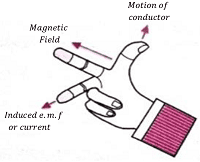What is called Electromagnetic Induction?
Electromagnetic induction is a phenomenon of production of electromotive force and thus a flow of electric current in a closed circuit caused by variation in magnetic field associated with the circuit. Electromotive force thus produced is called Induced EMF.
A moving magnet can produce electric current in a nearby stationary conducting loop by electromagnetic induction. Similarly, a conducting loop moving in a magnetic field of a stationary magnet gets induced emf. Induced current flows in the conducting loop so long as the loop moves in the magnetic field.
The phenomenon of producing induced EMF and hence induced current in a closed circuit due to the change in magnetic field or change in magnetic flux linked with the closed circuit is known as electromagnetic induction.
Faraday’s Laws of Induction
Michael Faraday of England is famous for his laws of electrolysis, electromagnetic induction, invention of electric motor, transformer etc. and Joseph Henry of United States is famous for his invention of electromagnetic motor etc.
On the basis of experiments, Faraday stated two important laws of electromagnetic induction as given below –
- Faraday’s first law or qualitative law of electromagnetic induction.
- Faraday’s second law or quantitative law of electromagnetic induction.
Faraday’s First Law of Electromagnetic Induction
Faraday’s first law of electromagnetic induction states that –
Whenever a magnetic flux inked with a conductor or coil changes an EMF is induced in it. This induced EMF lasts so long as the change in magnetic flux continues in the coil.
This law is popularly known as Faraday’s qualitative law of Electromagnetic induction.
Faraday’s Second Law of Electromagnetic Induction
Faraday’s second law of electromagnetic induction states that –
The magnitude of induced EMF is directly proportional to the rate of change of magnetic flux linked with the conductor or coil.
This law is popularly known as Faraday’s quantitative law of Electromagnetic induction.
Limitations of Faraday’s Laws of Induction
Faraday’s second law of electromagnetic induction has following limitations –
- It only gives the magnitude of induced EMF.
- It doesn’t tells about the polarity or direction of induced EMF.
However, direction of induced EMF was given by another scientist and is called Lenz law.
Magnitude of Induced EMF
Let, ( \phi_1 ) is magnetic flux linked with a coil at time ( t_1 ) and ( \phi_2 ) is the magnetic flux linked with the coil at time ( t_2 ) .
Then, rate of change in magnetic flux linked with the coil will be –
\left ( \frac {\Delta \phi}{\Delta t} \right ) = \left ( \frac {( \phi_2 - \phi_1 )}{( t_2 - t_1 )} \right )
Let, ( \epsilon ) is the induced EMF in the coil due to electromagnetic induction. Then, from Farady’s second law, the induced EMF in coil will be –
\epsilon \propto \left [ \frac {( \phi_2 - \phi_1 )}{( t_2 - t_1 )} \right ]
So, \quad \epsilon = k \left [ \frac {( \phi_2 - \phi_1 )}{( t_2 - t_1 )} \right ]
Here, ( k ) is a constant of proportionality. In SI system of units, the value of ( k = 1 ) .
Therefore, \quad \epsilon = \left [ \frac {( \phi_2 - \phi_1 )}{( t_2 - t_1 )} \right ]
= \left ( \frac {d\phi}{dt} \right ) …………. (1)
If a coil has ( N ) number of turns, then equation (1) can be written as –
\epsilon = N \left ( \frac {d\phi}{dt} \right )
Lenz Law
Lenz law gives the direction of induced EMF in a circuit. It states that –
The polarity or direction of induced emf in a circuit is such that it opposes the cause which produces it. This means that the direction of induced EMF in circuit is opposite to the direction of movement by which change in flux has occurred.
Therefore, \quad \epsilon = - N \left ( \frac {d\phi}{dt} \right )
Negative sign indicates that, induced EMF always opposes the change in magnetic flux.

Consider about a coil or closed loop and a bar magnet as shown in figure. It is observed that –
- When N (north) pole of bar magnet is brought towards the closed loop as shown in figure ( A ), counter clockwise current is developed in the loop. As per right handed screw rule or right hand thumb rule, this induced current produces a magnetic field in a direction which opposes the motion of the bar magnet. This means that, the nearer face of the loop behaves as N (north) pole of a magnet.
- When N (north) pole of magnet is taken away from the loop as shown in figure ( B ), the nearer face of the loop behaves as S (south) pole. Thus, the induced current in the loop opposes the motion of the bar magnet away from the loop.
Fleming’s Right Hand Rule

The direction of induced EMF or induced current in a conductor moving in magnetic field is determined by Fleming’s right hand rule.
It states that –
If the right hand is stretched such that the first finger, the central finger and the thumb are mutually perpendicular to each other and the First finger points along the direction of magnetic field while the Thumb points along the direction of the motion of the conductor, then the direction of induced EMF or induced current will be along the direction of the middle finger.
In a nutshell –
- Direction of Motion is along the Thumb.
- Direction of Field is along the First finger
- Direction of induced EMF – along the Middle finger.
Remember it as MT-FF-EM
This rule is also known as generator rule.
